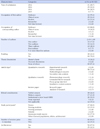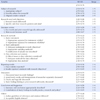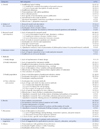Abstract
Purpose
The purpose of this study was to analysis the manuscripts rejected for publication in the Journal of Korean Academy of Nursing Administration during the last three years six months (2012~2015 Jun).
Methods
Seventy eight rejected manuscripts were analyzed focusing on manuscripts characteristics, such as rejection rates, year of submission, occupation of first author and corresponding author, number of authors, funding, thesis or dissertation, article type, study participants, number of reviews prior to rejection, and 3rd reviewer. Also reviewers' quantitative evaluation scores and subjective comments were analyzed. Reviewers' subjective comments were analyzed using content analysis methodology.
Results
The mean rate for manuscript rejection was 28.9% and for quantitative research, qualitative research, and review papers the quantitative evaluation scores were 2.54±0.70, 2.39±0.69, and 2.39±0.69 out of 5 points, respectively. The most frequent subjective comment on rejected manuscripts was 'lack of rationale for research need'.
Figures and Tables
References
1. Jang KS, Kim BN, Kim YM, Kim JS, Jeong SH. Analysis of research articles published in the Journal of Korean Academy of Nursing Administration for 3 years (2010-2012). J Korean Acad Nurs Adm. 2013; 19(5):679–688. DOI: 10.11111/jkana.2013.19.5.679.
2. Kang MY. Korea Journal Citation Report 2014 (KJCR 2014). Daejeon: Korea Institute of Science and Technology Information;2015.
3. Hwang SY, Yong JS, Kim NS, Park MH, Park YH, Oh EG. Direction for development of the Journal of Korean Academy of Adult Nursing through analysis of accepted and rejected papers (2007-2009). J Korean Acad Adult Nurs. 2010; 22(1):103–112.
4. Kim HW, Chung M, Park JS, Suh YO, Suk MH, Shin H, et al. Developmental direction for review system of the Journal of Korean Academy of Nursing. J Korean Acad Nurs. 2007; 37(3):422–430.
5. The Korean Academy of Nursing Administration. Revision notification: The guide for authors, and the review rules of the Journal of Korean Academy of Nursing Administration [Internet]. updated October 19 2012. cited 2015 October 10. Available from: http://society.kisti.re.kr/board/detail2.php?board=kana_8&tid=1&did=111303&count=10&type=b1.
6. Murthy US, Wiggins CE. Why manuscripts are rejected: An analysis of JIS rejections. J Inf Syst. 2002; 16(1):41–48.
7. Lee CC, Yun H, Hwang SH. Why your manuscripts were rejected or required a major revision: An analysis of Asia Pacific Journal of Information Systems. Asia Pac J Inf Syst. 2009; 19(2):179–193.
8. The Korean Academy of Nursing Administration. Notification: Journal of Korean Academy of Nursing Administration, Special edition [Internet]. updated October 17 2012. cited 2015 October 30. Available from: http://society.kisti.re.kr/board/detail2.php?board=kana_8&tid=1&did=111364&count=10&type=b1.
9. Kim JK, Jung MS, Jang KS, Kim J, Kim EK, Lee H, et al. Analysis of the Journal of Korean Academy of Nursing Administration for 3 years(2007-2009). J Korean Acad Nurs Adm. 2010; 16(4):517–526. DOI: 10.11111/jkana.2010.16.4.517.
10. Seomun GA, Koh MS, Kim IA. Classification of keywords of the papers from the Journal of Korean Academy of Nursing Administration (2002-2006). J Korean Acad Nurs Adm. 2007; 13(1):118–122.
11. Daft RL. Why I recommended that your manuscript be rejected and what you can do about it. In : Cummings LL, Frost PJ, editors. Publishing in the organizational sciences. 2nd ed. Thousand Oaks, CA: Sage Publications;1995. p. 164–182.
12. Song K. Use and misuse of statistical methods in the Journal of Korean Academy of Nursing Administration. J Korean Acad Nurs Adm. 2013; 19(1):146–154. DOI: 10.11111/jkana.2013.19.1.146.




 PDF
PDF ePub
ePub Citation
Citation Print
Print







 XML Download
XML Download